Pain de Campagne is a traditional French sourdough bread. It is a chewy and delicious loaf that is certain to become your favorite.
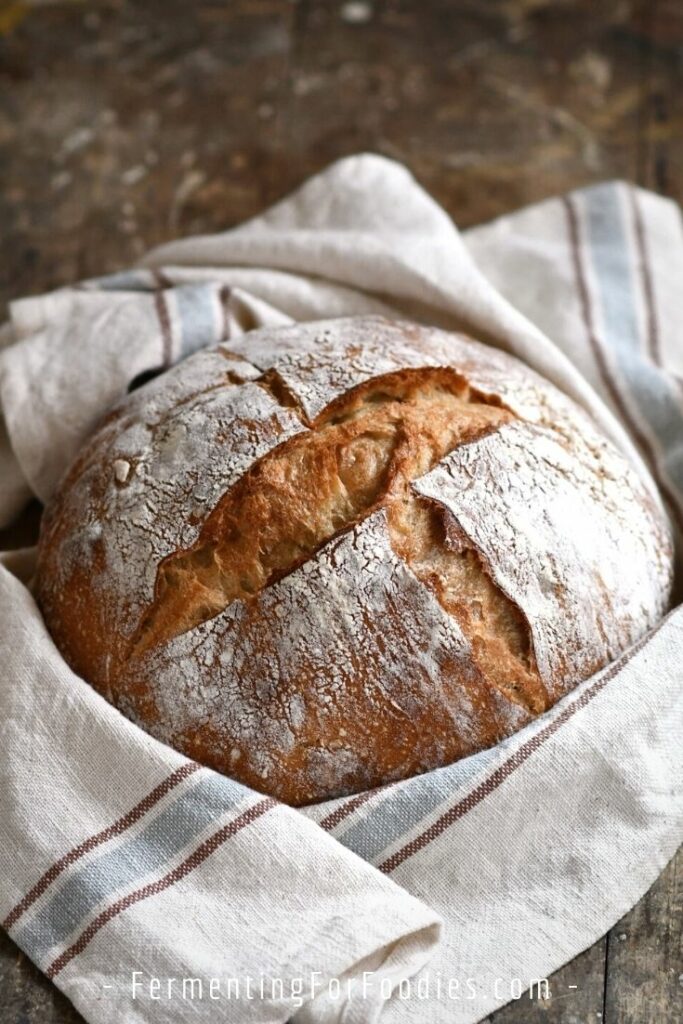
Imagine stepping into a bakery in rural France and pointing to a rusty brown loaf of sourdough bread resting in a basket next to several others. You know it’s not just a typical loaf, and the first bite confirms it. The crusty exterior gives way to a flavorful interior that is both soft and chewy.
Pain de campagne, roughly translated, means “countryside bread“. However, it is so much more than that. It is French sourdough bread with a fully developed gluten structure that achieves its complex flavor from the sourdough process.
This French sourdough bread recipe is my husband’s for everything from dinner rolls to sandwich loaves. And it is divine when served toasted with butter. In fact, it’s such a favorite that my 14-year-old has started baking loaves as well!
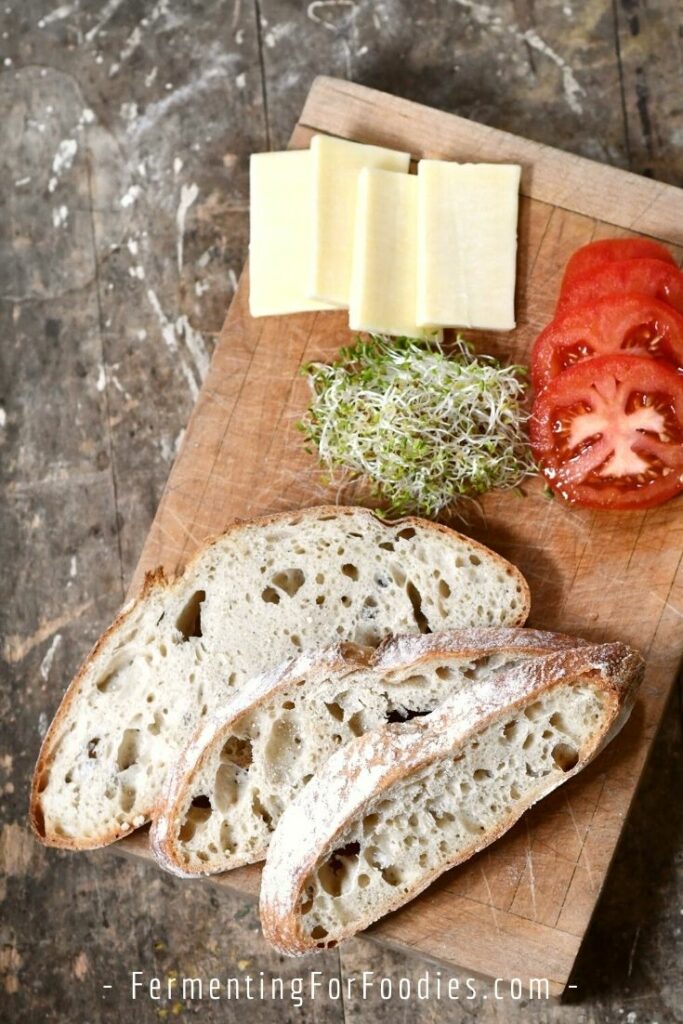
Adding flavors
French sourdough bread is strong enough to handle the weight of additional flavors and ingredients. This is a great way to take this simple bread and turn it into something a bit fancier! Walnut loaf makes delicious toast for breakfast. Kalamata olive bread is a nice dinner loaf.
How to add in extra ingredients
Here’s how to add in additional ingredients:
- Allow your dough to rest for 10 minutes after mixing in the salt and sourdough starter (step 2).
- After 10 minutes sprinkle the dough with the added flavors and ingredients. Don’t worry about mixing them in right away, as they will get mixed in during the folding procedure (step 3).
- Follow the usual rising, folding, and baking instructions provided in the recipe.
Not sure what to add to your loaf of bread? Here are a few of our favorite flavors:
- 2 cups of walnuts
- 2 cups of grated hard cheese
- 1 cup of caramelized onions
- 1/4 cup of mixed fresh herbs (parsley, basil and oregano) with 1 Tbsp of diced garlic
- 1 cup of pitted and chopped kalamata olives
- For a sourdough raisin bread, try making a sweet and soft barmbrack.
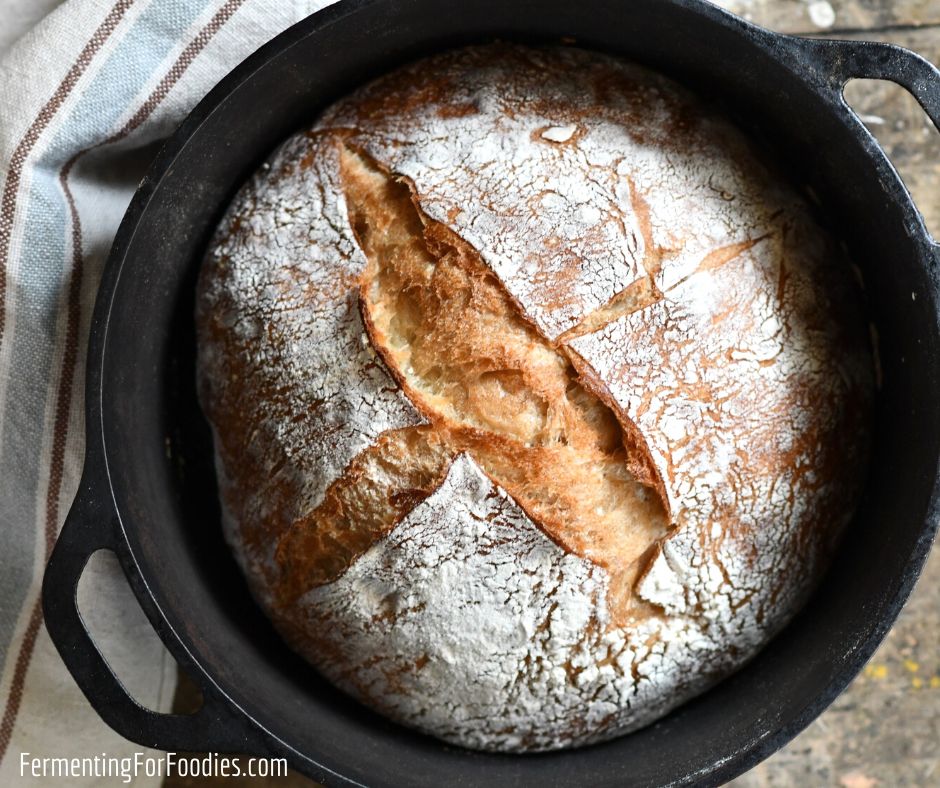
Rustic French Sourdough Bread
Traditional Pain de Campagne is rustic French sourdough bread. It starts with an active sourdough starter and follows traditional folding techniques for a perfect loaf every time. Try adding in a few extra ingredients like chopped garlic or kalamata olives. See the section above for details on how to add extra ingredients.
- Prep Time: 2 hours
- Cook Time: 50 minutes
- Total Time: 2 hours 50 minutes
- Yield: 2–3 loaves 1x
- Category: Bread
- Method: Sourdough
- Cuisine: French
- Diet: Vegan
Ingredients
- 22 oz warm water (2 3/4 cups, 650 ml)
- 26 oz strong white flour (about 5 3/4 cups, 737 g)
- 2 oz whole-grain flour (1/2 cup wheat or rye, 57 g)
- 1/4 oz amaranth (1 tbsp, 7 g – optional for authenticity)
- 12 oz sourdough starter (about 1 1/3 cup, 340 g)
- 1 Tbsp salt
Instructions
- This recipe doesn’t scale perfectly. If you’re planning on making a double batch, expect it to need a bit more flour.
- Warm the water to approximately 33 C / 93 F), and mix it with the flour. Leave the flour to hydrate for 15-30 minutes.
- Once the flour has hydrated, mix in the sourdough starter and salt. See my post on sourdough bread techniques for detailed instructions on how to add in ingredients, fold the dough and form a loaf.
- Allow to rise in a warm location until doubled in volume (about 6-12 hours depending on temperature). Use the dough folding procedure 3-4 times during this rise.
- Place the dough on a well-floured surface and cut into 2 equal pieces. Gently pull and shape the dough into a ball, using flour as needed. Avoid kneading as you don’t want to break the delicate bubbles.
- Place the dough balls in floured baskets (or bowls lined with floured tea towels) and allow them to rise one last time for 2 hours (or overnight in the refrigerator with a lid -see notes for details).
- Preheat to 500 F (250 C). Gently place the loaves in the baking dishes (see notes for options). Score the top of the loaf with a sharp knife.
- Bake for 30 to 50 minutes until brown. The exact timing will depend on whether your oven can get to 500F (mine can’t!). It also depends on whether you’re baking in a Dutch oven, loaf pan, or baking sheet.
- The loaf is done when the outside is nicely browned and the loaf sounds hollow when tapped. Cool on a rack before slicing.
Notes
- This bread recipe requires an active sourdough starter. Depending on the virility of your starter, you may want to add 1/2 tsp of commercial bread yeast. It is traditional for French loaves to contain a mixture of commercial yeast and starter. Just reduce the initial rising time to 4-5 hours if you use commercial yeast.
- Doing a final rise in the fridge is not only convenient, but it helps to develop the sour flavor. The cooler temperature slows down the yeast, allowing the bacteria to work on the flour. To rise in the fridge line a bowl or banneton in a flour-dusted tea towel. Then cap it with a plate. Bake the bread directly from the fridge (there’s no need to warm up the dough).
- Depending on the shape that you want, you can bake this bread in a loaf tin
or a baguette pan. Use a pizza stone
for a flatter loaf or dinner rolls. If we’re baking baguettes or sandwich loaves, we rise the bread directly in the tin.
- We like using a cast iron Dutch oven to make a traditional boule. For the best rise and even browning, place the iron Dutch oven in the oven to preheat. Then bake the loaf in the already hot Dutch oven for 30 minutes with the lid on, then cook uncovered until it has browned (about 20 minutes).
- We have played around with increasing the amount of whole wheat flour in this recipe. It works with up to about 3 cups of whole wheat flour. For a whole-grain loaf, I recommend using my husband’s whole-grain sourdough bread recipe instead.
Nutrition
- Serving Size: 2 slices
- Calories: 147
- Sugar: 0.1g
- Sodium: 351 mg
- Fat: 0.4g
- Saturated Fat: 0.1g
- Carbohydrates: 30.7g
- Fiber: 1.1g
- Protein: 4.2g
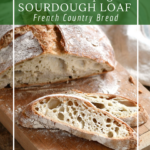

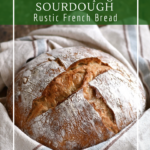
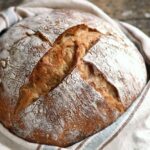
This has quickly become my favorite bread recipe. It’s just the right amount of chewy.
Did you use Amaranth?
We’ve been making this bread for at least 4 years, and often include amaranth. It’s added for the flavour. If you don’t have it, the just replace it with another whole grain flour. It just adds richness to the white bread.
Do I fold the dough within the mixing bowl or tip it onto a floured surface?
I fold it in the bowl. Good luck!
Can’t rate yet as I’ve not tried it. I do want to know why Amaranth is used and in what way it increases the authenticity of the recipe.
Do you use the whole amaranth grains or amaranth flour?
Amaranth flour, however, it’s really just for the flavour. If you can’t find it, use a different whole grain flour.
thank you!!! I’m trying this all for the first time. Love the detail in your recipes, thank you!
Thanks!
I have a question: What is the chemistry/science behind mixing the water with the flour first, them mixing in the starter later. I have been mixing starter, water and salt then adding the flour to make a stiffer dough that your ingredients produced and waiting an hour before doing the first dough turn. Your recipe/method produced a softer more elastic dough with better “holes” in the final product. I find your website very interesting – now I know what to do with the leftover whey when I make greek yogurt!
Starting with hydration of the flour allows for autolyse (basically it activates the enzymes in the flour for self-digestion). The result is better flavour and texture!
Glad the website is helpful!
salt prevents the autolyse, that’s why it’s added at the end.
Do you grease the pans?
Also do you really bake the bread at 500’ for 50 minutes or do you turn the temperature down to 350’ after pre-heating the oven?
Hi Carol, If you’re baking in a cast iron pan (preheated in the oven) don’t grease it. However, if you’re baking in a glass or tin, then grease it. And we do bake it at 500 for the full time. However, if you’re not using the dutch oven, then you may want to lower the temperature after 20 minutes. Enjoy!
Way to high of heat for way too long! After all of that work. It’s all burned.
I’m sorry to hear that your bread burnt! This is a recipe that we have been making for years and it’s one of the most popular recipes on my blog (with several hundred people making it each week). This is the first time I’ve heard of someone burning their bread, however, I will make a note in the recipe to check the bread after 30 minutes. Cheers, Emillie
Hello Emillie, your bread looks great! Do you mind sharing what kind of flour you are using? I have been baking sourdough successfully with Canadian Hard White (13% protein), but have had to switch to French T65 (Campaillet des Champs), which is all that is available right now. The dough is very wet, I am just not getting the strong gluten development and oven spring that I am used to. I am on my fourth batch, have reduced the hydration and still not struggling! Thank you.
We typically use Anita’s flour for our gluten bread: https://anitasorganic.com/ That might only be available locally. We’ve also used Roger’s bread flour in the past, but it’s been a few years. It is interesting how different flours act differently. It sounds like your new flour is lower in gluten than your old flour. Maybe try following our whole grain sourdough recipe? Regardless, lower gluten will mean a denser, moister loaf.
Good luck!
Having so much fun with this. First batch with bad flour still tasted delicious. Second batch looks good but is not firming up. Dough after 8 hours of rising and folding is rising well but remains moist, sticky and flattens. Does not hold a shape. Too much starter? Not enough flour? I’m weighing out the ingredients!.
Interesting that you had different hydration rates between your first loaf with bad flour and your second loaf. Bread is a bit of an art. Lots of factors can affect the water/flour ratio. Properties of the flour (carbs/protein), humidity, hydration of your sourdough starter etc. If it feels too wet, then trust your instincts and add a bit more flour. Just a few tablespoons might make the difference. Good luck!
Why so much salt?
The salt is more for flavour than rise (though it does help control the rise). Feel free to reduce it if you want. However, I’ve never had anyone find the bread too salty. 🙂
Thanks for the clarity of the process and the ingredients. I have done with a good result with the sourdough made with white flour. In france the sourdough starter is made with which flour. I guess it would different flavour.
Even different white flours will have their own unique flavour. Glad you enjoyed the bread!
This looks great! I would like to add yeast as you suggested. What step do I mix in the yeast? Into the starter? Or step 1?
You could mix it in step 1 or 2. It doesn’t really make much of a difference. Enjoy!
Can you bake one large loaf in a 7 qt Dutch oven, as opposed to 2 loaves, and if so, does the baking time and temperature change?
One large loaf would definitely take longer to bake. I wouldn’t reduce the initial heat since it’s what gives the bread the nice crust. However, I would turn it down to 400F after 30 minutes and let it cook for longer. I’m not exactly sure how much longer, as I haven’t personally made 1 large loaf. So maybe check it every 15 minutes. The bread will be done when you can tap the bottom of the loaf and it sounds hollow. Good luck!
Hi! I’m excited to try this recipe! Can I halve the recipe? How would that impact bake time?
The recipe makes two loaves, so halving it shouldn’t affect the baking time. However, if you want to make smaller loaves, then you would need to decrease the baking time. I haven’t tried it, so maybe start checking the loaves after 30 minutes of baking time?
I wish there was a few more details in the recipe–are we supposed to knead it after adding the sourdough starter? If so, for how long? What should the texture be–a soft dough? Firm? smooth? sticky? During the initial rise we are supposed to be folding at some point…where are the instructions for how to do this? I usually make sourdough boule’s….wondering if you make one or two? So many questions….
Hi! My sourdough forming techniques are linked to in the notes at the bottom of the recipe: https://www.fermentingforfoodies.com/basic-sourdough-bread-technique/ It’s much more detailed with pictures as to how to add ingredients and form the boules. No kneading involved as kneading breaks down the bubbles into small, regular-sized air pockets rather than rustic larger air pockets. And I typically make 2 or 3 loaves depending on how large I want them to be.
I’ll do a quick edit to make the instructions more clear.
Cheers! Emillie
If refrigerating overnight, do you bake the cold dough or bring it to room temperature?
We bake cold. The instant heat of the hot oven will get the yeasts going again.
I haven’t tried this recipe b/c it’s not gluten free. I have made a similar Pain de Campagne recipe by Jennifer Katzinger. Only because it’s gluten free. The inside was soft and very tasty. But the crust was really hard. Does anyone know what I did wrong or what I can do to make the crust softer next time?
Hi Ann,
I’m actually entirely GF, so this recipe belongs to my husband. 🙂 I will tell you that GF bread and gluten bread really aren’t the same at all. Very little of the techniques used overlap. I haven’t tried that particular GF bread recipe. However, I do know that rice and starches generally result in a hard crust. I recommend trying my GF sourdough buns, which might be similar? Though they are soft on the outside, you could make them more crusty by baking at a hotter temperature. Here’s the recipe: https://www.fermentingforfoodies.com/perfect-gluten-free-sourdough-buns/
Cheers, Emillie
After trying dozens and dozens of recipes over the years, this is THE ONE. It is so delicious, moist, chewy, holey and perfect. I won’t waste my time on any other recipes. My little question: do you ever do the final rise overnight in the fridge? I’m trying to figure out how I can have a freshly baked loaf before noon. I use a banneton but was afraid my dough might dry out in the fridge (put it in a ziplock?) Some people say to let the dough come to room temperature before baking the next morning, others say just pop it in the oven. Any suggestions you have is greatly appreciated!
This is my husband’s recipe. He always does the overnight rise in the fridge. He lines two glass bowls with non-fuzzy tea towels, sprinkles a bit of flour over them, then puts in the ball of bread. He caps them with a glass plate and stacks them in the centre of the fridge. It’s our zero-waste method and was used for the photographed loaf. He always pops the cold loaves right from the fridge into the hot oven. One goes into cast iron dutch oven and the other into a tin loaf pan. Cheers!
This just brings back such delicious memories!
Hi Emilie the island dwelling fermentation enthousiaste.
I am relatively new at bread but very much enjoying the loaves as I progress. Have had more luck with commercial grandchild yeast in French T65 and stone ground T85 loaves but not so much when using sourdough.
Hopefully your recipe will do the trick. Will certainly post back tomorrow.
In the meantime would be great if you could post gram equivalents for all the European bakers 🙂
Thanks again for your tips and insights
Olivier
I’m actually in Canada, so we’re metric too. However, 80% of my visitors are from the USA, so I default to imperial. 🙂 I’ve added metric now. The exact makeup of your local wild yeasts may be influencing your sourdough vitality. There are regionally specific strains, and buying a strain online won’t help. They’re quickly colonized by local strains. If you find your sourdough starter doesn’t provide enough rising action, just add 1/4 tsp of yeast to this recipe and hopefully that will make up the difference.
Good luck!
How long should I knead the dough for it should I skip kneadi g for 15-20 minutes because I am folding it during the first proof??
This is a no-knead bread! The folding is all you have to do. Enjoy!
Hi Emille
What type of salt are you using? Do have a weight of salt to use?
Bread looks wonderful!
Thanks
I use pink Himalayan salt, but since it’s mostly for flavour, you can use whatever you want. It’s about 17g. Enjoy!
I have been baking sourdough for over 2 years now. I stumbled onto your recipe and it is perfection. I used sorghum flour in place of amaranth because I had it on hand. Thank you for sharing.
Absolute favorite recipe. I am baking weekly and loving it. Trying rolls this weekend. Need some guidance on the final rise. Should I divide into small balls and let rise the 2 hours before baking? What temp how long? Any guidance is appreciated.
Sorry if I’m too late in my reply. I just got back from my internet-free cottage. I would follow the same rising time, 2 hours should be perfect. However, you’ll want to reduce the temperature for softer buns. I haven’t personally tried it, but maybe 400 F for 30 minutes? Let me know how it goes!
Hi Emily. I have a question about the weight of the starter in the recipe. The levian’s volume change but the weight is constant. Thank you.
Sorry! Just realized I wrote down the starter in ml… but the oz is by weight. Fixed it now… 340g. Cheers, Emillie
I have made this recipe twice now… absolutely divine flavor and texture! However, the dough is always SO sticky and doesn’t hold it’s shape Bec it’s so wet. I am fairly new to sourdough baking, could it be that my starter is too wet or overly hydrated? (I typically feed it 1:1 of flour:water). What consistency should I look for in the dough, and is it ok to just add more flour? Thanks!
Hi Emily,
There is a bit of an art to baking bread. People try to take that aspect out of it by weighing all the ingredients and trying to make everything as precise as possible. But lots of factors influence hydration: humidity, type of flour, etc. My personal philosophy is that precision doesn’t matter, as most loaves of bread are delicious without it. 🙂 This bread is a rather soft dough… however, it should be able to hold a loose form. The softness helps with making those large air bubbles and crusty exterior. If you feel that the dough could use a bit more flour, feel free to add just a few spoonfuls more. Eventually, you’ll find a balance that works best for you. Enjoy!
Thank you! I’ll be trying it again soon. 🙂
Hi, Emilie! I made this bread for the first time today, and it is so tasty! I appreciate that this recipe allows for a little more flexibility and “art” than others I have tried. One quick question clarify before next time I bake: do you add in the starter immediately after feeding it, or when it is due for a feed? I checked your sourdough techniques post, but didn’t see the answer there—sorry if I missed it somewhere!
Great question! I would remove the starter right before feeding so it’s nice and hungry. Enjoy!
Perfect—thanks so much!
Is the level of hydration correct here? I halved the recipe 325 grammes of water (1 liter of water at sea level = 1kg). My starter was very active. I added 3/4 teaspoon of dry yeast. 5 hours and three foldings later I still have a very, very wet dough (albeit it is bubbling away). No way this is even close to any sort of firmness let alone a “window pane” test.
It is a wet dough, and you won’t be able to do the windowpane test. However, it should develop gluten after a few folds, but it will remain a soft dough. The extra moisture helps with the final texture (like sponge bread or ciabatta). Saying that… feel free to add a bit of extra flour when forming the boule. Don’t knead it in, just form the loaf with a bit of extra flour. It’s always fine to adjust sourdough bread to suit your starter. Hope it works out for you!
Thanks. Sounds like I should let it do its thing a while longer. At the moment I could literally pour it like I would the starter.
Hum… that seems a bit too liquidy. Are you able to grab the dough to fold it? This post: https://www.fermentingforfoodies.com/basic-sourdough-bread-technique/ shows what the dough looks like when we make it. Maybe you should add a bit more flour? Try 1/4 cup at a time.
Yes it was way too wet. It was that way before adding the sourdough starter (nothing like the pic at your other link which I had gone through). Perhaps I made a mistake but I don’t think so. It meant the dough couldn’t hold structure once out of the banneton. It just flattened into the base of my Pyrex dish ‘n lid. I scored the dough but those scores disappeared during the bake and likely inhibited the rise in the oven. So I got a wide flat flattish loaf of about 3 inches in height and not really a boule. The interior was certainly full of air pockets (just as in the pic above) and the crust ok (but not cracked, more smooth). In that sense it was basically the same as other methods I have tried. (eg Patrick Ryan’s sourdough masterclass on ilovecookingireland on YouTube. BTW his seeded sourdough is absolutely excellent and his baguettes are awesome.) The taste was that of a simple sourdough. I did not add the amaranth.
In a pain de campagne I’m looking for a less sour, light white bread with a very defined crunchy crust. Obviously the sourness comes from the starter vs dried or fresh yeast. I’ve also tried Raymond Blanc’s method which uses a dried/fresh yeast and a preferment to build flavor. I’ve made that following his recipe with both white and rye flour and also using just white. The taste was excellent but it didn’t develop that thick crunchy crust I was seeking. Hence trying something new.
If I try this again I will drop the hydration 10% (possibly more). But if you have a very live, recently-fed starter culture I believe you’ll get the same texture needing the dough to the window pane test, letting it rise, knocking it back, shaping and using a good, long slow last rise in the fridge overnight etc. (My starter is about 1 and 1/2 years old now.)
Hi Steve, I really don’t know what happened with your loaf. This is one of my most popular recipes and we’ve made it a number of times. I wonder if it’s because of the scaling? From your first comment, it sounds as though you halved the recipe, then added a 3/4 of additional yeast? That would cause the bread to rise then deflate. It also may contribute to the flavor. If you are looking for a less sour loaf, then I recommend skipping the overnight rise in the fridge. The cooler temperature rise favors the bacteria rather than the yeast for a more sour loaf. Cheers!
Hi. I just added a little dried yeast (3/4 teaspoon). It was already very wet prior to adding any starter. (I didn’t do the overnight rise but I will take on the point.)
Perhaps this statement requires some clarification:
“This bread recipe requires an active sourdough starter. Depending on the virility of your starter, you may want to add 1/2 tsp of commercial bread yeast. It is traditional for French loaves to contain a mixture of commercial yeast and starter. Just reduce the initial rising time to 4-5 hours if you use commercial yeast.”
I waited circa 8 hours of waiting for the dough to dry (it was left uncovered at room temp) more than anything else. It would help possibly if you stated how much yeast (starter and dry or fresh bakers) should be used if a mix is deployed and how much if only dry/fresh yeast is used. Plus the time period.
Anyways it will get eaten and I thank you for posting the recipe.
We’re due to make a loaf of bread this week. Though we’ve been making the recipe for years, I’ll play around with it and see what could be going on for you. Cheers!
Thanks for this recipe! I played around with other bread books before, but this is a pretty simple (and apparently failproof!) version. I made a batch of sourdough using your technique using some local whole grain Red Fyfe (took ~ 10 days to get it nice and bubbly), then I made my first batch 100% whole wheat. Worked out pretty well, but there wasn’t a lot of loft in the loaf. My son absoultely loved the flavour though; he said it was his favorite ever!
Just finished another loaf and did this one 50/50 with the Red Fyfe whole wheat and white; still really tasty but with some bigger air pockets (not as big as your photo above, but getting close).
Glad that it worked with all red fyfe. I honestly haven’t tried that. Thanks for sharing! 🙂
I have tried this twice and I find that, even before adding the starter, the autolysed dough is much too wet. I have had to add so much more flour to be able to stretch and fold it. I use French T55 flour — is that the problem?
That may be the issue. T55 has less protein than regular flour, which is why it’s used for croissants and puff pastry. My husband regularly makes this recipe with locally milled white flour or a mix of white and coarse wheat (he does have to adjust the amount of flour when he adds the coarse ground wheat). Breadmaking is both an art and a skill… feel free to add a bit more flour to get the desired texture. Cheers!
Thank you!